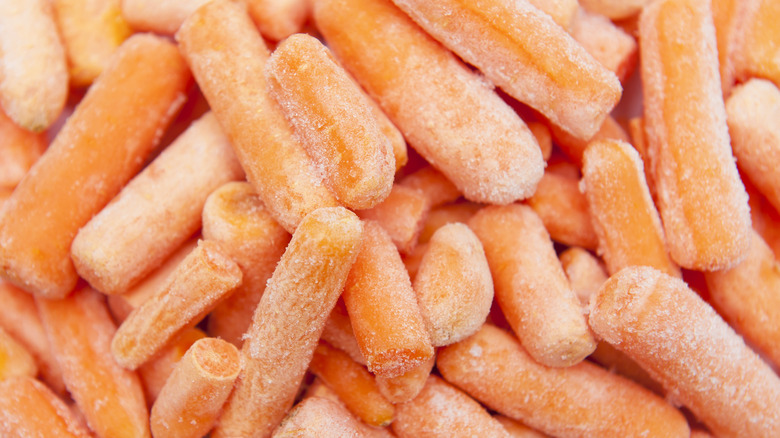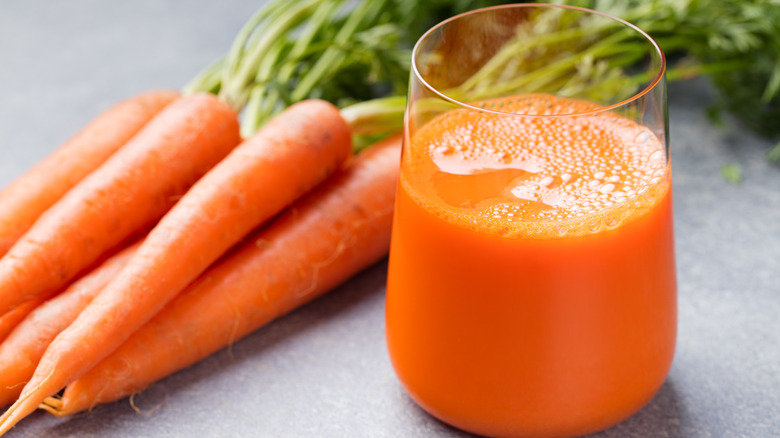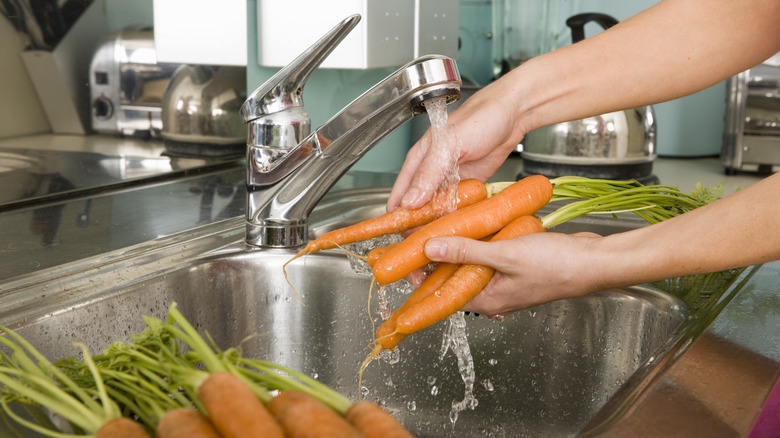The Mistakes To Avoid When Freezing Carrots
Carrots are the world's eighth most popular vegetable. Since they're oh-so-common and relatively inexpensive, carrots are one of those ingredients that's easy to buy lots of and then struggle to use up (unless you adopt a carrot-based diet for the foreseeable future). Fortunately, carrots are an ideal vegetable for storing frozen. If prepared and used correctly, they can last for up to a whole year in the freezer, with only minor changes to their taste. However, there are a few things to avoid when freezing carrots to make sure you get the best results.
Firstly, when freezing carrots, you're usually looking to end up with uniform frozen pieces that are loose, not stuck together in an icy clump. This makes it easy to grab just the amount you need for your recipe without having to crack out the chisel. To avoid a carrot ice block, simply spread your prepped carrot pieces out on a baking sheet and freeze them overnight like this, then transfer the individual pieces into a container and return them to the freezer.
Secondly, blanch your carrots for substantially better results when storing them frozen. Blanching your carrots positively impacts how their flavor, color, texture, and even nutrients hold up after freezing. Peel and chop carrots into pieces of your desired size, blanch them for a couple of minutes, chill them in ice water, dry them off, and then freeze.
The versatility of frozen carrots
Frozen carrots are a true utility vegetable. The blanching step part cooks them, reducing the cooking time when you use them from frozen. For quick, low-hassle use carrots are usually prepped into batons or slices before they're frozen. In this form, frozen carrots are at their most versatile. Mostly simply, they can be thrown into a smoothie for a veggie boost that also chills your drink, but just like fresh carrots, they can be put to use in a plethora of ways. You can use them to make stock at home or as a pleasing simple side of roasted caramelized carrots. Or boil them a little more, blend them, and make a creamy carrot soup.
It's best to freeze carrots when they're still quite fresh, so they still have a bit of bite. If it's too late for that, you can always extend their shelf life by fermenting or pickling them instead, just remember it's probably a good idea to peel them first. On the other hand, if you have plenty of firm, fresh carrots but decide for whatever reason to omit the blanching step, spread finely chopped carrots onto a tray or in molds so they freeze in blocks, then transfer these to a container. However, unblanched frozen carrots are best used within just two weeks – nowhere near the 12-month storage for blanched frozen carrots — a major reason it's generally a mistake to skip this step!
Making the most of your carrots
Freezing fresh carrots is one of the best ways to make sure you use them, but there are a few parts of the carrot that commonly get left unused, whether or not the rest is frozen. The peel, the base with its stem (and sometimes the carrot tip as well), and the green carrot tops are often scraps worthy for the bin, but they're well worth making use of.
Before peeling carrots, wash and scrub them to remove potential pesticides and dirt from the outside. Once peeled, you can use this peel in stocks, or dry them out a little and fry them in oil for a crispy salad topping. Alternatively, you can dehydrate them in the oven overnight, then blend them into a fine powder and use this carrot peel dust to add earthy umami to dishes. Carrot bases and carrot tips can also be added to stock, or made into dust if they're chopped finely before dehydrating, along with any peel you have. Carve out the bottom of the stem with a pairing knife and discard, if desired.
Green carrot tops are also usually thrown away at home, but they have fragrant herb-like qualities and are a fantastic, underrated ingredient. They're part of the parsley family, and can be used similarly to parsley in many recipes; they add a sweet crunch to salads, and can also be used to make carrot top pesto, an earthy-yet-aromatic alternative to the classic basil pesto.


